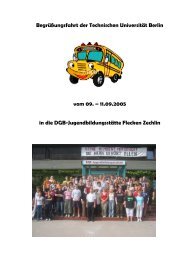Elegantes Telefax - JAV der TUB - TU Berlin
Elegantes Telefax - JAV der TUB - TU Berlin
Elegantes Telefax - JAV der TUB - TU Berlin
You also want an ePaper? Increase the reach of your titles
YUMPU automatically turns print PDFs into web optimized ePapers that Google loves.
33<br />
result of a combination of causes: The inclusion of environmental evaluation procedures<br />
in operational policies which made the planning of these projects more timeconsuming<br />
and cost-intensive for the Bank and the staff, potentially revealing the lack<br />
of economic feasibility of proposals is certainly a contributing factor. Another more<br />
direct effect can be attributed to the international campaigning against the dams in<br />
general which resulted in the Inspection Panel and in the cancellation of two dams<br />
which were relatively well advanced in their internal process: Sardar Sarovar and<br />
Arun II. The inability of staff to answer the questions of the Inspection Panel added to<br />
the reduced incentive of operational staff to support dams.<br />
The reduction of lending for hydropower and for other hydraulic infrastructure has<br />
implication for the level for IBRD lending, which constitutes the core of lending of the<br />
World Bank. These activities form the basis of the relative autonomy of the World<br />
Bank as an agent. As Kapur pointed out, the expansion of IDA-based loans reduces<br />
the autonomy of an MDB and it needs to maintain the loan-based share of its activities<br />
(Kapur 2002). The major customers for these loans are middle-income countries<br />
which have access to other sources of financing nationally and internationally. This<br />
diagnosis is repeated again in the WRSS, its accompanying documents and in the<br />
Infrastructure Action Plan (IAP). As the process of developing the WRSS and IAP<br />
have been designed by the higher management in cooperation with the Board of ED<br />
to focus on these borrowers and to give international NGOs a reduced role, compared<br />
to the WCD process, it seems clear that the Bank changed it course to placate<br />
the major borrowers and it accepted the potential increase in conflicts with the international<br />
NGOs.<br />
The Bank’s management seems to be aware that resumption for hydraulic lending<br />
risks a resumption of NGO-campaigning against new dam projects and an effective<br />
use of the leveraging in the US Congress and in the US Treasury. The proposed<br />
“new business model” of elevating the responsibility these projects to “corporate” projects<br />
is designed to deal explicitly with the complexity of these projects and their applicable<br />
criteria. The NGOs are not convinced that their concerns will be adequately<br />
addressed (Bosshard et al 2003).<br />
Another interesting observation concerns the process leading to the water policy<br />
document. The 1993 Water Resource Management Policy Paper was based on a<br />
comparatively low key internal process which reflected probably changes in the preferences<br />
among the major principals and which served as a basis for integrating policy<br />
views within the Bank’s management and staff. It seems as if the NGOs were<br />
largely excluded from it despite the smaller workshops; although they managed to<br />
reach selective Executive Directors, but a real impact is not discernable. With these<br />
characteristics, the influence of the NGOs was consi<strong>der</strong>ably lower compared to all





